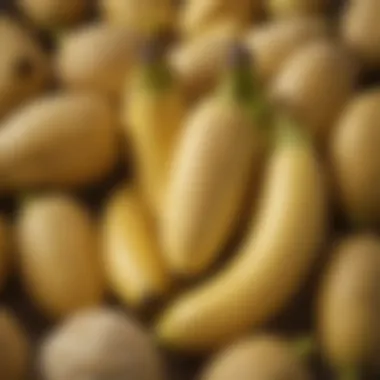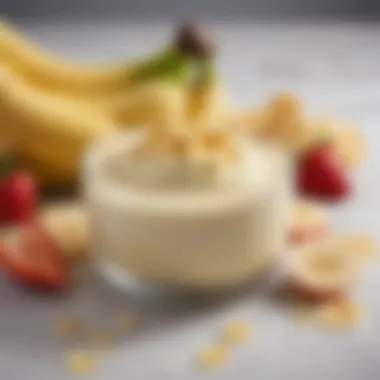Master the Art of Making Banana Pudding


Intro
Banana pudding stands as a cherished dessert in many households, especially in the Southern United States. Its combination of soft, ripe bananas layered with creamy pudding, coupled with the crunch of vanilla wafers, offers a delightful textural contrast that many find irresistible. Making banana pudding may appear simple, but the nuances in the ingredients and methods can elevate this dessert from ordinary to extraordinary.
In this guide, we will take an in-depth look at the process of making banana pudding. Each aspect, from selecting the best bananas to understanding the role of each ingredient, will be discussed thoroughly. We will also explore various preparation techniques that can enhance flavor and presentation. This knowledge aims to not only assist novice cooks but also provide experienced bakers with new insights into this traditional recipe.
Whether you're preparing a family feast or simply indulging in a sweet treat, knowing how to create a truly satisfying banana pudding can bring joy and satisfaction to many occasions.
Preamble to Banana Pudding
Banana pudding stands as a deeply beloved dessert in many households. Its appeal lies not only in its delicious taste but also in the simplicity of its preparation and the rich sensory experiences it offers. This article aims to explore the nuanced aspects of making banana pudding, allowing both novice and seasoned cooks to gain a deeper understanding of the dish.
The importance of the introduction to banana pudding is rooted in its historical context and cultural relevance. Understanding where this dessert originated and its significance across various communities enhances appreciation for its flavors and traditions surrounding it. The aim here is to illuminate the foundational features of banana pudding, including its key components and variations. Each layer, from the creamy pudding to the fresh bananas, orchestrates a harmonious blend of taste and texture that transcends mere satisfaction in dessert.
Historical Context
Banana pudding traces its roots back to the early 19th century. It emerged as a popular dessert in the United States, particularly in the Southern states. The combination of bananas and pudding became notable owing to the availability of bananas, which were introduced to the U.S. in the 19th century. Initially, the preparation might have included various forms of custard, but over time, recipes evolved.
Throughout its development, banana pudding became a staple at family gatherings, community events, and significant celebrations, reflecting a sense of togetherness. The layering of bananas, cookies, and custard created not just a dessert, but also a shared experience among those gathered.
Cultural Significance
Banana pudding holds a prominent place in Southern culture. It serves as more than just a dessert; it represents warmth, familial bonds, and hospitality. In many Southern homes, serving banana pudding is a tradition that conveys love and care. This dessert is often made during holidays, parties, and gatherings, marking moments in people’s lives.
Moreover, the dessert's adaptability allows it to be reinvented, reflecting personal tastes or dietary considerations. Its status is further amplified through countless interpretations found across family recipes and cookbooks, showcasing the ways in which different cultures have embraced and modified it.
"Banana pudding is not merely a dish; it embodies memories, traditions, and even the tastes of a generation."
In summary, the historical and cultural dimensions of banana pudding add depth to its enjoyment. Understanding these aspects allows individuals to not only savor the dessert but also to connect with its legacy.
Essential Ingredients
Understanding essential ingredients is crucial for crafting the perfect banana pudding. Each component not only adds to the flavor but also contributes to the texture and overall success of the dessert. Choosing quality ingredients can elevate the dish and provide a more satisfying experience.
Bananas
Bananas are the star of banana pudding. Their sweetness and creamy texture are fundamental to the dessert's appeal. Ripe bananas bring a natural sweetness that can reduce the amount of added sugar required. The right ripeness is key; overripe bananas often become mushy, while under-ripe bananas may lack flavor. For the best results, look for bananas that are yellow with a few brown spots.
Pudding Base
The pudding base is the heart of banana pudding. Its creamy consistency and flavor depend on the quality of the individual ingredients used.
Milk
Milk is essential in achieving a smooth and creamy pudding. Whole milk is a popular choice due to its richness, contributing to a more decadent texture. It provides a balance of sweetness without overpowering the natural flavors of the bananas. While using non-dairy alternatives is possible, they may alter the final texture and taste. Whole milk creates a creamy base that supports the structure of the pudding.
Eggs
Eggs play a critical role in the pudding base, acting as a thickening agent. When cooked, eggs help stabilize the pudding, ensuring it holds its shape. They add richness and depth of flavor to the dessert. It is essential to use fresh eggs for the best results. While egg-free alternatives exist, using eggs often yields a more traditional and satisfying pudding.
Sugar
Sugar enhances the pudding’s sweetness and balances the flavors. Granulated sugar is commonly used, as it dissolves easily into the pudding base. The amount of sugar can be adjusted based on the ripeness of the bananas. Over-sweetening can detract from the dish's other flavors, so measuring carefully is important. Sugar not only adds sweetness but also contributes to the thickening process.


Vanilla Extract
Vanilla extract is a crucial ingredient that elevates the overall flavor profile of the pudding. It offers a warm, aromatic quality that complements the bananas. Pure vanilla extract is preferable for its more intense flavor compared to imitation vanilla. One should be cautious with the amount added, as too much can overwhelm the dish. The warmth of vanilla rounds out the sweetness and enhances the experience of enjoying banana pudding.
Nilla Wafers or Alternatives
Nilla Wafers are the classic choice for layering in banana pudding. Their light and crispy texture contrasts well with the creamy pudding and soft bananas. They also absorb some moisture from the pudding while maintaining their shape. For those seeking alternatives, options like shortbread cookies or graham crackers can work in a pinch, though they each introduce different textures and flavors.
Optional Toppings
Toppings add the finishing touch to banana pudding, enhancing both appearance and flavor. They can bring contrast and additional textures.
Whipped Cream
Whipped cream adds a light and airy element to the dessert, enhancing its overall creaminess. It can be made from heavy cream, offering richness that complements the pudding. The lightness of whipped cream balances the dense nature of the pudding. It is important to use fresh whipped cream as canned varieties may contain stabilizers that alter texture. A dollop on top can make every serving look appealing.
Chocolate Shavings
Chocolate shavings provide a delightful contrast to the sweetness of banana pudding. They add a rich, decadent touch that can elevate the dessert's complexity. Dark chocolate shavings are a popular choice for their slight bitterness, which counters the sweetness. However, it's vital to consider personal taste, as some may prefer white chocolate for a sweeter profile. Using high-quality chocolate shavings can transform the dessert into an indulgent treat.
Overall, each of these essential ingredients plays a significant role in creating a delicious banana pudding. Careful selection and preparation are fundamental to achieving the desired outcome. Nouessuring each component works together harmoniously will enhance the final result.
Preparation Steps
Preparation of banana pudding is not merely about putting ingredients together; it is a delicate balance of technique and timing. Understanding the importance of each step can significantly enhance the final outcome. Mastery in preparation will lead to a pudding with perfect consistency and delicious flavor.
Preparing the Pudding
Combining Ingredients
Combining ingredients is essential because it sets the foundation for the pudding. You need to mix milk, eggs, sugar, and vanilla extract in a specific order. This method allows flavors to meld and prevent clumps. The key characteristic of this step is ensuring even distribution throughout the mixture. This step is vital as it creates a smooth texture. A beneficial choice here is to whisk rather than stir. Whisking introduces air, which can result in a lighter pudding. However, care must be taken not to overmix, as this might affect the structure.
Cooking Technique
The cooking technique involves heating your combined mixture until it thickens. A double boiler is often preferred because it provides gentle heat, which is less likely to scorch the ingredients. The unique feature of this method is that it allows heat to distribute evenly. Steady stirring is crucial here to ensure that the mixture cooks uniformly. Using a thermometer helps in achieving the correct temperature, avoiding the disadvantage of overcooking that might lead to scrambled eggs.
Cooling Process
Cooling the pudding is essential because it allows the flavors to develop further while achieving the right texture. After cooking, transferring the pudding to a chilled bowl helps quicken the process. The key characteristic is that cooling enhances the overall richness of the dessert. Leaving it undisturbed during the cooling process ensures a creamy consistency. A downside to consider is impatience; skipping this cooling phase can result in a thin or overly warm pudding that won't hold its shape well during assembly.
Slicing Bananas
Choosing the Right Ripeness
Selecting bananas at the perfect ripeness enhances both the flavor and texture. A ripe banana is sweeter and creamier, making it more suitable for pudding. The key characteristic is finding that sweet spot, where the banana has developed plenty of natural sugars without being mushy. Choosing the right ripeness creates a pleasant balance of texture in the dessert. If bananas are under-ripe, they produce a starchy taste that does not complement the pudding well. Thus, careful selection impacts the overall flavor.
Slicing Technique
Slicing technique matters as it influences the visual appeal and the distribution of banana flavor in each serving. Each slice should be approximately a quarter-inch thick. This thickness allows them to hold shape but also easily blends with other textures in the dish. A key characteristic of this technique is uniformity in size; it makes for more aesthetically pleasing layers. Improper slicing can yield either too thick pieces that are hard to eat or too thin ones that may dissolve into the pudding.
Layering the Dessert
First Layer of Wafer


The first layer of wafers is where the dessert begins to take shape. Placing them at the bottom helps establish a sturdy base. A popular choice is using Nilla Wafers, which adds a sweet crunch that perfectly offsets the creamy pudding. This key characteristic adds an essential contrast in texture that enhances the overall experience. Moreover, ensuring they are evenly placed helps with the structural integrity of the dessert. If this layer is not arranged properly, it can lead to a messy presentation.
Adding Pudding
Adding pudding on top of the wafer layer is crucial as it brings moisture and flavor to the dessert. When you pour the pudding, make sure to cover all wafers completely. This ensures each bite has a mix of flavors and textures that is important for enjoyment. Evenness in this layer contributes to the dessert's layered appearance. Care must be taken to avoid pushing the wafer layer down; otherwise, it may disturb the overall structure.
Repeat the Process
Repeating the process of layering is what builds the dessert's complexity and richness. Each layer adds to the height and depth of flavor, resulting in a more satisfying experience. The key characteristic of repeating layering is achieving balance. This means equally distributing pudding and wafer with each layer. However, it is essential to keep track of how many layers you add, as too many might make the dessert too heavy to maintain structural integrity. A well-executed repeat process results in an appealing and delicious banana pudding.
Chilling and Serving
Chilling and serving are essential stages in the banana pudding preparation process. This step significantly influences the texture and flavor of the dessert. Proper chilling ensures that the pudding sets correctly, leading to a creamy consistency. Furthermore, serving methods can enhance the presentation and overall enjoyment of this classic dish.
Chilling Time
Recommended Duration
The recommended duration for chilling banana pudding is generally at least four hours. This period allows the layers to meld together. This duration is beneficial because it helps integrate the flavors of bananas, pudding, and waifers. The unique feature of this four-hour chilling period is that it not only affects the taste but also the desired creamy texture. The pudding becomes firmer and more enjoyable upon serving. Not chilling for long enough leads to a runnier consistency, which is often less appealing to many.
Importance of Chilling
The importance of chilling lies in its ability to enhance the overall quality of banana pudding. Chilling helps the pudding set, allowing the components to bond and deliver a more cohesive flavor profile. What's key about this step is that it mitigates the risk of the dessert becoming too loose. This can be crucial for presentations at gatherings or events. If one skips the chilling process, they might face a dessert that is not only visually unappealing but also difficult to serve.
Serving Suggestions
Presenting in Individual Cups
Presenting banana pudding in individual cups is a popular choice for gatherings. This method does enhance convenience, allowing each guest to have their own portion. The appealing aspect of this serving style is that it makes portion control easy. Individual servings allow for more creativity in presentation, catering to many personal preferences. However, the downside might be the need for more cups, which can increase waste, especially if not everyone finishes their pudding.
Garnishing Options
Garnishing options are vital in elevating the visual appeal of banana pudding. Some popular choices are crushed Nilla wafers, slices of fresh banana, or a dollop of whipped cream. What stands out with garnishing is that it adds texture and flavor, making the dish even more enticing. A unique feature of garnishing is that it can create a personalized touch for each serving. While these garnishes offer visual appeal, it's essential to consider that overly rich toppings may overpower the delicate flavors of the pudding. They should complement rather than dominate.
Variations of Banana Pudding
Exploring variations of banana pudding presents both an opportunity for creativity and a way to accommodate diverse dietary preferences. This section delves into two main categories: health-conscious options and flavor enhancements. Understanding these variations allows you to adapt the classic recipe to suit various tastes, making banana pudding a versatile dessert that can appeal to a broader audience.
Health-Conscious Options
Using Plant-Based Milk
Using plant-based milk in banana pudding can significantly alter the overall dish, making it suitable for lactose-intolerant individuals or those following vegan diets. Almond milk, soy milk, or oat milk are popular choices. They maintain a creamy consistency while providing essential nutrients. This option offers a distinct advantage for those looking to reduce dairy but still enjoy a rich flavor profile.
One key characteristic of plant-based milk is its lower saturated fat content compared to cow's milk, making it a healthier choice. However, it is important to note that the flavor profile can vary depending on the type of milk used. For instance, almond milk adds a nutty undertone, while soy milk is more neutral. Some find that using plant-based milk can result in a thinner pudding, so using a thickening agent might be necessary.
Reduced Sugar Alternatives
Reduced sugar alternatives present another way to make banana pudding more health-conscious. By substituting traditional sugar with options like stevia or monk fruit sweetener, you can enjoy the dessert with fewer calories and without sacrificing sweetness. These alternatives not only minimize the risk of a sugar crash later but also make the dessert more suitable for those monitoring their sugar intake, such as diabetics.
One of the main characteristics of reduced sugar alternatives is their concentrated sweetness, which allows for less quantity to achieve the same level of sweetness. However, it is important to balance betweentaste and health, as the unique flavor of some sweeteners might differ from traditional sugar. Therefore, experimenting with various ratios can lead to a custom experience.
Flavor Enhancements


Adding Peanut Butter
Integrating peanut butter into the banana pudding elevates the dessert by adding a nutty flavor and nutritional profile that includes protein. This variation is particularly beneficial if you desire a richer taste without needing to modify the dessert extensively. The creamy texture of peanut butter blends well with the pudding, enhancing mouthfeel.
One unique feature of adding peanut butter is its ability to provide a deeper flavor that pairs beautifully with bananas. However, one must consider the natural sweetness of peanut butter, ensuring it does not overwhelm the dessert. A key point here is to use natural peanut butter with no added sugars for a healthier approach.
Using Chocolate Pudding
Substituting traditional vanilla pudding with chocolate pudding creates an entirely different dessert experience. Chocolate pudding introduces a deep and rich flavor that pairs well with bananas, attracting chocolate lovers. This variation also adds visual appeal, creating an inviting contrast with the bananas' light yellow hue.
The main advantage of using chocolate pudding is the simple switch it provides to make the dessert feel more indulgent. However, it is crucial to ensure that the chocolate flavor does not overshadow the bananas, maintaining a balance between both elements. Additionally, this version benefits from the inherent sweetness of chocolate, which might reduce the need for added sugar.
Common Mistakes to Avoid
When preparing banana pudding, being mindful of common mistakes is essential. These errors can alter the final outcome, affecting both texture and flavor. Avoiding these pitfalls ensures that the resulting dessert lives up to expectations and delivers a delightful experience.
Overcooking the Pudding
One significant mistake that home cooks often make is overcooking the pudding. This process requires careful attention to heat and timing. When the pudding is cooked for too long, it can become grainy or separate, resulting in a less appealing consistency.
Most pudding recipes suggest cooking over medium heat while continually stirring. This helps achieve a smooth texture. It's crucial to remove the pudding from heat as soon as it thickens to the desired consistency. Once you notice it starting to bubble, giving it an extra minute or two is usually enough. If unsure, removing it slightly early is better, as it will continue to thicken as it cools. Always taste the pudding before entirely cooling it, as it allows you to spot any undesirable textures early on.
Using Under-Ripe Bananas
Using under-ripe bananas can greatly diminish the flavor profile of banana pudding. The sweetness and creaminess of ripe bananas are central to the dessert’s taste. A banana that is too firm lacks the softness required for layering, plus it tends to be less sweet.
When selecting bananas, aim for those that are fully yellow with some brown spots. These are at peak ripeness, providing a creamy texture and rich flavor. If your bananas are not ripe, you can speed up the ripening process by placing them in a paper bag at room temperature. Adding an apple or tomato can further enhance this process due to the ethylene gas they emit.
Incorrect Layering Technique
The layering of ingredients in banana pudding is not just about aesthetics; it affects the overall taste and texture. Incorrect layering technique can lead to a soggy dessert or uneven distribution of flavors.
To achieve the best result, start with a base layer of Nilla Wafers or an alternative, followed by a layer of pudding, then banana slices. Repeating this process helps to create a rhythm in flavor and texture. Each ingredient's moisture is essential to consider, as the cookies will absorb some of the pudding's moisture, softening them while retaining some crispness. When layering, be careful not to overfill the layers, allowing room for the pudding to settle properly without spilling over the edges.
To create an authentic banana pudding, attention to detail in cooking and assembling is crucial.
By avoiding these common mistakes, the end result can be a banana pudding that is truly memorable, showcasing the flavors and textures that make this dessert a classic.
Closure
The conclusion of this article is crucial as it synthesizes the key insights about making banana pudding, highlighting the journey from selecting the right ingredients to the final presentation.
Recap of Key Steps
The art of making banana pudding involves several essential steps that contribute to its overall flavor and texture.
- Selecting Ripe Bananas: Choose bananas that are perfectly ripe, with a good balance of sweetness and firmness.
- Preparing the Pudding Base: Master the pudding base using milk, eggs, sugar, and vanilla extract. This forms the dessert’s creamy foundation.
- Layering: Proper layering of Nilla wafers, bananas, and pudding is essential to attain the desired texture and flavor fusion.
- Chilling: Allowing the dessert to chill enhances the flavors and results in a well-set pudding.
- Serving Suggestions: Creative presentation in individual cups can make the dessert visually appealing.
Each of these points encapsulates the essence of making banana pudding and serves as a reminder of the precision required in the process.
Inviting Culinary Exploration
Banana pudding is more than just a dessert; it is a platform for creative expression in the kitchen. Its simplicity invites cooks of all levels to experiment.
- Consider variations like peanut butter or chocolate pudding, which can offer unexpected flavors.
- Health-conscious options such as plant-based milk provide an avenue for those seeking alternatives without sacrificing taste.
Engaging with banana pudding can inspire culinary curiosity, urging cooks to tweak traditional recipes or create entirely new ones. Through this exploration, one can appreciate cooking as an evolving art.
The possibilities are vast, and the only limitation is the imagination of the cook.







